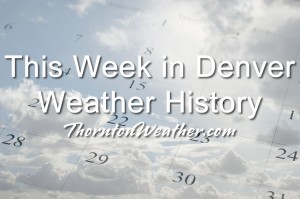
April in Denver can bring a wide array of weather conditions, many of which appear in their most extreme form. Our look back at this week in Denver weather history demonstrates this with everything from major snowstorms to damaging windstorms to even a tornado.
From the National Weather Service:
6-8
In 1973…a major spring snow storm dumped 11.6 inches of snowfall over metro Denver. North wind gusts of 30 to 35 mph produced some blowing snow. Most of the heavy wet snow… 10.1 inches…fell on the 7th when temperatures remained in the 20’s. Snow accumulated on the ground to a maximum depth of 9 inches. Low temperature of 5 degrees on the 8th was a new record minimum for the date and the lowest for so late in the season.
7-9
In 1913…heavy snowfall totaled 10.9 inches in downtown Denver behind a cold front. Most of the snow fell on the 8th. Northeast winds were sustained to 35 mph with gusts to 38 mph on the 9th.
In 1935…moderate dust blew into the city around 9:00 pm on the 7th and persisted until early afternoon on the 9th. Southeast winds were sustained to around 20 mph on the 7th and 8th. Winds shifting to the west at sustained speeds to 20 mph cleared the dust from the air on the 9th.
7-12
In 1959…snow falling over a 5-day period totaled 20 to 30 inches just east of the mountains…while over the plains blizzard conditions closed schools and blocked highways. The second big storm in two weeks dumped 16.4 inches of snowfall on Stapleton Airport with the most…11.6 inches… Occurring on the 8th. East winds gusted to 37 mph on the 9th. Temperatures dipped into the single digits on the mornings of the 7th and 12th when 7 degrees were registered. Low temperature records for the dates were set on the 9th…10th…and 12th. The cold temperatures caused streets to glaze with ice…resulting in the death of a pedestrian who was struck by a car in Denver. Three people died from heart attacks while shoveling the heavy… Wet snow.
8
In 1885…dense smoke polluted the air until noon.
In 1887…south winds were sustained to 42 mph.
In 1890…northwest winds were sustained to 48 mph with gusts as high as 60 mph.
In 2005…a mixture of strong pressure gradient winds coupled with thunderstorm outflow winds produced high winds across metro Denver. The high winds downed power lines and knocked out electricity to about 19 thousand customers on the east side of metro Denver. High wind reports included gusts to 68 mph in Longmont…61 mph near Castle Rock…59 mph at Centennial Airport…and 54 mph at Denver International Airport.
8-10
In 1999…a windstorm caused 20 million dollars in damage along the Front Range urban corridor from Fort Collins south to Pueblo and to the east over the plains…making the storm equal to the costliest windstorm ever…which occurred in Boulder on January 17…1982. In metro Denver… Several homes were damaged as shingles were blown off roofs. Large pieces of a roof torn off a strip mall in Lakewood damaged several cars in a parking lot. Most of the damage to homes consisted of broken fences…awnings…doors…and windows. Scores of automobiles suffered broken or cracked windshields and paint damage from flying debris. Multiple accidents were triggered as several tractor-trailer rigs were blown on their sides by the strong cross-winds. Blowing dust and dirt caused near zero visibilities at times. Both I-25 and I-76 were closed north and northeast of Denver. State Highway 93 was closed between Golden and Boulder. Several trees…power poles…and power lines were downed…causing a number of outages as well as sparking a few small grass fires. Highest wind gusts reached 112 mph atop Niwot Ridge near the Continental Divide west of Boulder…102 mph at Wondervu…100 mph at the National Center for Atmospheric Research mesa lab in Boulder…98 mph at the national wind technology center near Broomfield…96 mph on Rocky Flats…92 mph at Jefferson County Airport near Broomfield and on the University of Colorado campus in Boulder…and 90 mph at Highlands Ranch in southwest metro Denver. Winds gusted to 48 mph at Denver International Airport.
9
In 1950…strong southwest winds gusting to 58 mph reduced the visibility to 1 mile in blowing dust at Stapleton Airport. Scattered minor wind damage…consisting of falling tree branches and damage to signs…occurred across metro Denver.
In 1989…6 to 12 inches of snow fell at many locations in the Front Range foothills. Boulder received 6 to 8 inches. Five inches (5.0 inches) of snow fell at Stapleton International Airport…causing 2 hour flight delays. I-25 south of Denver was closed for 4 hours due to a 100- car traffic pileup. North winds gusted to 33 mph at Stapleton International Airport where the maximum snow depth on the ground was only 3 inches due to melting.
Continue reading April 8 to April 14 – This Week in Denver Weather History







 April marks a transition between winter and summer for most of the country but for Denver it is especially true as we can see a stunning variety of weather. The proverbial April showers are certainly a possibility for Denver.
April marks a transition between winter and summer for most of the country but for Denver it is especially true as we can see a stunning variety of weather. The proverbial April showers are certainly a possibility for Denver.